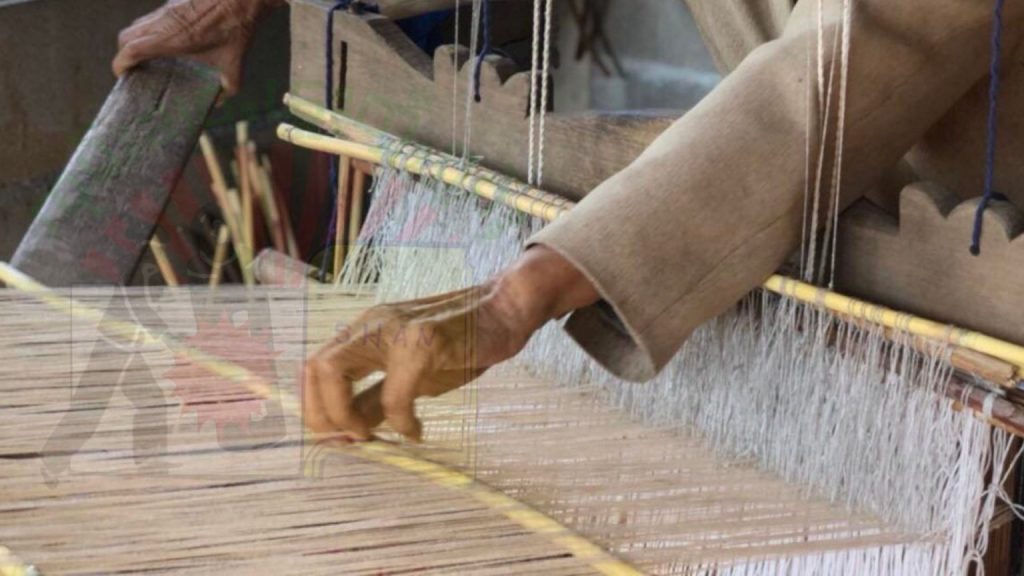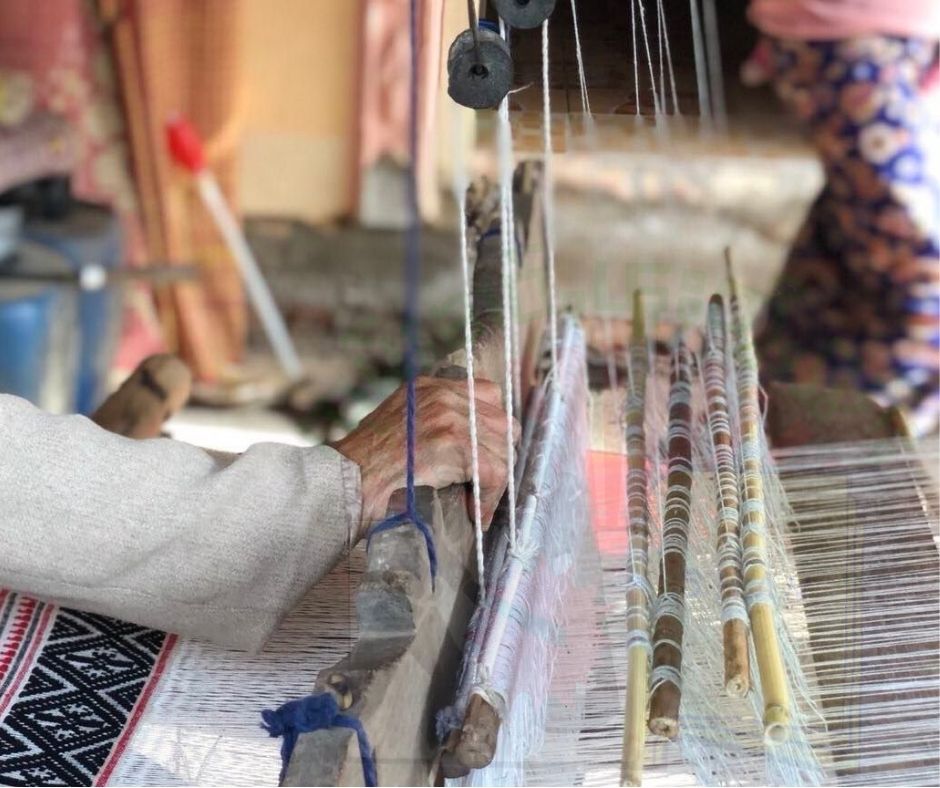“Because of the deforestation, natural dyeing ingredients are hard to find nowadays. Only three households are producing the fabric, and they are all aged now,” explained by Pa Soi who lives in Nar Goung village , Langkho Township , southern Shan State.

Nar Goung is one of the small villages in Langkho district. It is famous for its Shan traditional fabric weaving and agricultural produces.
Langkho is located in Southern Shan State, and geographically situated in the lowest sea level among other districts; thus, the weather is very humid.
The famous agricultural products from Langkho are Virginia tobacco, lentils, peanuts, sesames, and sugarcane. Another well-known locally produced product is the dark blue Shan traditional woven fabric.
“Those products have been traded from generations to generations, and some are exported into foreign markets,” according to a 40-year Langkho resident Nang Hom, and she added that the locally produced Virginia tobacco has been exported to China and Thailand, and the lentils are exported to India.
Before 1996-97, the naturally dyed Shan traditional woven fabrics, which was traded into Yunnan province, Kunming city, China, came from this small village called Nar Goung in Langkho district.
“They use the natural ingredients from trees bark to dye the dark blue color of the woven fabric in Nar Goung. This traditional way of producing Shan fabric was widely used before the notorious “four cuts” incident in Southern Shan State,” the Langkho resident Nang Hom continued telling the story.
The four cuts strategy is implemented by the Myanmar junta in Southern Shan State in 1996, aiming to restrict access to food, funds, intelligence and recruits, the strategy seeks to starve the support base of armed resistance and turn civilians against resistance groups. Because of that many civilians were tortured and killed which caused the Nar Goung villagers fleeing and relocating including those dedicating to Shan traditional woven fabrics.
“Because of the conflicts in the area, the villagers were fleeing into a neighboring country. Also, the natural dyeing plants are rare now. In the past, people grew cotton; however, almost none is growing it now. That is the reason less people are producing Shan traditional woven fabrics,” Nang Hom narrated the reasons why once famous locally made Shan fabric is disappearing.
Currently, only three people continue producing Shan traditional woven fabric, one of them is already 70 years old.
“The three are baby boomers who have been through many developments. Among them, one is already 70 years old. The other two are also in the elderly group. If they pass away, the traditional woven fabric in Nar Goung could be vanished,” a Nar Goung local, Pa Soi told SHAN and added that there are no young generation who would take over the traditional woven fabric business.
“This used to be a symbolic product of Langkho. If the young generation is not continuing this traditional business, this will become extinct and it can only be seen in history photographs later on. In order to preserve this symbolic product, young generation has a responsibility to maintain it from vanishing,” Pa Soi expressed her concerns.
Even though Nar Goung villagers are depending on other agricultural businesses, many have gone abroad to seek for better job opportunities. Because of that and the deforestation, Shan traditional weaving business is no longer attracting the locals.
“It is taking a lot of time and effort to get one woven finished product. The raw materials are scarce nowadays, and few people are doing it. It has reached to the point of making no profit; therefore, people are changing their career,” Nang Hom relayed the current scenario to SHAN.
The young who should be working on the traditional fabric production are mostly searching for better jobs abroad. Also, the inadequate supply of raw materials such as cotton is another reason for abandoning the Shan traditional fabric weaving.
Due to the variety of fabrics produced from the computerized machine in the market, the locally handmade traditional woven fabrics have lost their market shares. Concerns are mounted that the symbolic traditional handmade fabric would disappear.
“Consumers prefer the products coming from Thailand and Inn Lay lake. Few customers are using our traditional handmade products, and they are made on pre-order basis only now. Our products can no longer compete in the market,” a Nar Goung villager, Sai Hsur told SHAN.
The computerized weaving products from Thailand and Inn Lay lake are dominating the market, and the Shan traditional weaving fabric is losing its market shares.
The dark blue woven fabric from Nar Goung is not only the symbolic product of Langkho but also convenient to wear in the local humid weather.
According to Nang Hla, an owner of a weaving business, “We have heard about this Langkho Shan traditional woven fabric since we were young. The natural organic materials used to produce the fabric makes it comfortable to wear in any weather condition.”
She also added that scarce raw materials, market disruption, and deforestation are the main factors that affect the Langkho dark blue traditional fabric weaving business.
“The tree barks used for dyeing the fabric are scarce now. Other raw materials such as cotton is not abundant anymore. Also, it cannot keep up with the market trend. For example, people tend to wear the traditional clothing along with others such as jean trousers or jacket – we should be aware of this kind of trend,” Nang Hla expressed her perspective on the market trend.
According to Langkho residents, if people only value and desire the new innovative modern styles without preserving the ordinary traditional handmade products, the historic symbol and culture of the local will disappear.
“Our people prefer those imported new and modernized products. They failed to realize the value of things closer to them, such as the unique traditional handmade clothing. If the cultural association does not conserve it, it will be vanished,” one Langkho native told SHAN.
The naturally dyed dark blue color Shan traditional woven fabric is used to make Shan traditional costumes for both men and women. Additionally, the fabric is used to produce jacket, towel, bag, and head turban.
It is believed that the older the fabric, the smoother it becomes; thus, it used to be a well-known symbolic product of Langkho. Nonetheless, it is on the verge of cultural extinction because of the lack of interest from young generation and business prospect.




